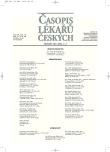Rhodococcus equi Infection in Subjects Infected with Human Immunodeficiency Virus (HIV)
Authors:
H. Rozsypal; V. Aster; M. Staňková; B. Horová 1
Authors‘ workplace:
III. klinika infekčních a tropických nemocí 1. LF UK a FN Na Bulovce, Praha
; Oddělení klinické mikrobiologie FN Na Bulovce, Praha
1
Published in:
Čas. Lék. čes. 2007; 146: 163-167
Category:
Case Report
Overview
Disease caused by Rhodococcus equi is a rare complication in subjects infected with human immunodeficiency virus (HIV) and it is associated with severe cellular immunodeficiency. The agent is gram-positive rod of the group non-diphtheric corynebacteria. The genus Rhodococcus belongs to the family Nocardiaceae and order Actinomycetales. The principle of pathogenicity is the survival inside macrophages. Formation of necrotising granulomas is a characteristic feature. Malacoplakia can be a specific cytological finding. Symptoms of disease include wet cough, fever and pleuritic chest pain. Problems persist many weeks before admission to the hospital. Chest X-ray and CT scan of the lungs show cavitary pulmonary lesions. Agents grow not only from the sputum specimen and also from samples received by bronchoscopy. In 50 % of cases it can be revealed in hemoculture. Outcome is poor; mortality rate is reported to be over 30 %. Better survival can be found in subjects who managed efficient antiretroviral therapy. Recommended treatment of Rhodococcus equi pneumonia includes particularly vancomycin, amikacin, rifampicin, imipenem, ciprofloxacin and erythromycin. Rhodococcus equi infection in an HIV positive subject is reported in case study of 52-year old man with AIDS with cavitary necrotising pneumonia and induced pericarditis, where the agent grew in hemoculture. This Rhodococcus equi pneumonia is the first case and till now the only one Rhodococcus infection in HIV patients described in the Czech Republic.
Key words:
human immunodeficiency virus (HIV), HIV infection, immunodeficiency, pneumonia, Rhodococcus equi.
Labels
Addictology Allergology and clinical immunology Angiology Audiology Clinical biochemistry Dermatology & STDs Paediatric gastroenterology Paediatric surgery Paediatric cardiology Paediatric neurology Paediatric ENT Paediatric psychiatry Paediatric rheumatology Diabetology Pharmacy Vascular surgery Pain management Dental HygienistArticle was published in
Journal of Czech Physicians

Most read in this issue
- Chronic Appendicitis – Vanishing or Current Diagnosis?
- Pathogenic Entamoeba histolytica – A Rare Incidence in Persons Microscopically Positive for Cysts in Faeces
- Liver Diseases of the Infectious Aetiology
- New antibiotics, efflux pumps and overcoming resistance
